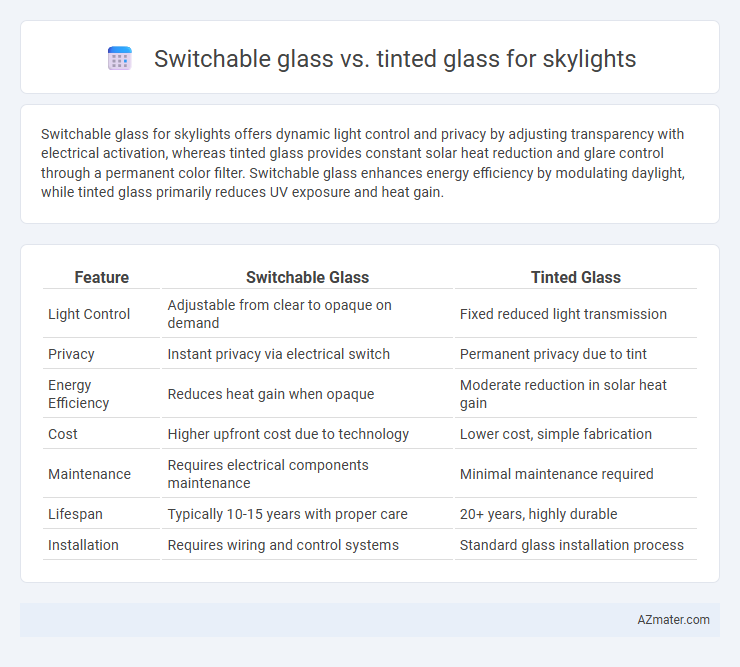Switchable glass for skylights offers dynamic light control and privacy by adjusting transparency with electrical activation, whereas tinted glass provides constant solar heat reduction and glare control through a permanent color filter. Switchable glass enhances energy efficiency by modulating daylight, while tinted glass primarily reduces UV exposure and heat gain.
Table of Comparison
| Feature | Switchable Glass | Tinted Glass |
|---|---|---|
| Light Control | Adjustable from clear to opaque on demand | Fixed reduced light transmission |
| Privacy | Instant privacy via electrical switch | Permanent privacy due to tint |
| Energy Efficiency | Reduces heat gain when opaque | Moderate reduction in solar heat gain |
| Cost | Higher upfront cost due to technology | Lower cost, simple fabrication |
| Maintenance | Requires electrical components maintenance | Minimal maintenance required |
| Lifespan | Typically 10-15 years with proper care | 20+ years, highly durable |
| Installation | Requires wiring and control systems | Standard glass installation process |
Introduction to Skylight Glazing Options
Skylight glazing options primarily include switchable glass and tinted glass, each offering unique benefits for light control and energy efficiency. Switchable glass uses advanced electrochromic technology to change transparency, allowing users to adjust natural light and privacy levels dynamically. Tinted glass provides a fixed solution by reducing solar heat gain and glare through permanent coloration, enhancing comfort and reducing UV exposure.
What is Switchable Glass?
Switchable glass, also known as smart glass, uses electrochromic technology to change from transparent to opaque with the application of an electric current, providing dynamic light control and privacy for skylights. Unlike tinted glass, which has a fixed shade that reduces sunlight and heat but cannot be altered, switchable glass offers customizable transparency to optimize natural lighting throughout the day. This adaptive feature enhances energy efficiency in buildings by controlling solar heat gain and glare while maintaining clear views when desired.
Understanding Tinted Glass for Skylights
Tinted glass for skylights reduces solar heat gain and glare by absorbing and reflecting a portion of sunlight, improving energy efficiency and indoor comfort. It comes in various shades and colors, designed to balance natural light with UV protection and privacy without compromising visibility. Understanding tinted glass helps homeowners select the optimal level of tint to enhance both aesthetics and functional benefits in skylight installations.
Light Control and Privacy Comparison
Switchable glass provides dynamic light control by electronically adjusting transparency from clear to opaque, offering maximum privacy on demand, unlike tinted glass which passively reduces light intensity and glare but maintains a consistent level of visibility. Tinted glass lowers heat gain and UV exposure by filtering sunlight, yet it does not block views or provide privacy, making it less versatile for skylight applications where privacy is essential. Switchable glass's ability to instantly modulate light transmission enhances energy efficiency and occupant comfort in skylights, surpassing the fixed performance of tinted glass.
Energy Efficiency and UV Protection
Switchable glass for skylights offers superior energy efficiency by dynamically controlling light and heat transmission, reducing the need for artificial cooling and heating. Its ability to switch from transparent to opaque helps block up to 99% of harmful UV rays, protecting interior furnishings from fading. Tinted glass provides constant UV protection but lacks the adaptive energy-saving benefits of switchable glass, making it less efficient in varying sunlight conditions.
Durability and Maintenance Requirements
Switchable glass for skylights offers enhanced durability due to its laminated structure and electrochromic technology, which resists scratches and UV damage more effectively than traditional tinted glass. Maintenance for switchable glass is minimal as it requires only regular cleaning with non-abrasive materials and no additional treatments to maintain its functionality. In contrast, tinted glass may experience fading over time and often requires periodic re-coating or replacement to sustain its performance and appearance.
Aesthetic and Design Flexibility
Switchable glass offers dynamic control over light and privacy, allowing skylight transparency to shift from clear to opaque at the touch of a button, enhancing aesthetic versatility in modern architectural designs. Tinted glass provides a fixed, consistent color that reduces glare and heat gain while maintaining a sleek, uniform appearance but limits adaptability in changing design preferences or lighting conditions. The ability of switchable glass to transform visual ambiance and interior lighting contrasts with the permanent, style-specific nature of tinted glass, making it ideal for projects prioritizing design flexibility and customizable aesthetics.
Cost Analysis: Switchable vs Tinted Glass
Switchable glass for skylights typically costs between $50 and $100 per square foot, significantly higher than tinted glass, which ranges from $15 to $40 per square foot. The installation of switchable glass often requires additional electrical components and maintenance, further increasing overall expenses compared to the more passive tinted glass options. Despite higher upfront costs, switchable glass offers dynamic light control and privacy benefits that can reduce long-term energy costs, while tinted glass provides a fixed solar control solution at a lower initial investment.
Installation Process and Considerations
Switchable glass for skylights requires electrical wiring and integration with control systems, making its installation more complex and typically demanding professional expertise. Tinted glass installation is simpler, as it functions like standard glazing and does not require additional electrical components or connections. Considerations for switchable glass include power source availability and maintenance of the electronic components, while tinted glass considerations focus on the type of tint and its impact on natural light and heat transmission.
Best Use Cases for Each Skylight Glass Type
Switchable glass is ideal for commercial spaces or smart homes where privacy control and energy efficiency are priorities, allowing users to adjust opacity instantly while reducing glare and UV exposure. Tinted glass serves best in residential skylights or sunrooms where constant reduction of heat and sunlight penetration is desired without the need for dynamic privacy or light control. For skylight installations that require flexibility in light management and privacy, switchable glass outperforms, whereas tinted glass excels in fixed, cost-effective solar heat gain control.

Infographic: Switchable glass vs Tinted glass for Skylight
 azmater.com
azmater.com